Web Application Development
Building Fast, Intelligent, and Experience-Driven Digital Ecosystems
At Sense & Respond Software, we don’t just build websites — we craft intelligent digital ecosystems that learn, adapt, and scale with your business. By combining AI-driven engineering, human-centered design, and modern web architectures, we deliver web applications that are fast, secure, and continuously improving.
Our philosophy is simple:
Mobile platforms have become intelligent ecosystems — merging software, hardware, and cloud. These visuals anchor our technology choices.
The Global Web Landscape (2024–2025)
Digital transformation today is driven by a fusion of AI, data, and design. Understanding these trends is essential to building web applications that are future-ready and sustainable.
Frontend Reality:
React dominates professional development (41.6%) followed by Angular (19.4%) and Vue (16.6%) — defining the modern web interface ecosystem.
Backend Momentum
JavaScript (66%) and Python (57.9%) lead the stack, powering APIs, automation, and AI-driven backends.
Cloud Context
AWS (30%), Azure (20%), and Google Cloud (13%) continue to drive 80%+ of global web infrastructure.
Global Talent Hubs
India remains the engineering backbone of global IT, while the United States leads in digital innovation, AI adoption, and cloud maturity.
AI-Driven Development
We integrate AI not only into the applications we build, but also into the way we build them.
AI-assisted development
for faster code generation and reviews
Test generation and refactoring
using machine learning models
Smart observability
with anomaly detection and root-cause prediction
AI in UX
personalization, predictive search, conversational experiences
The Global Web Landscape (2024–2025)
Frontend Framework Usage (2024)
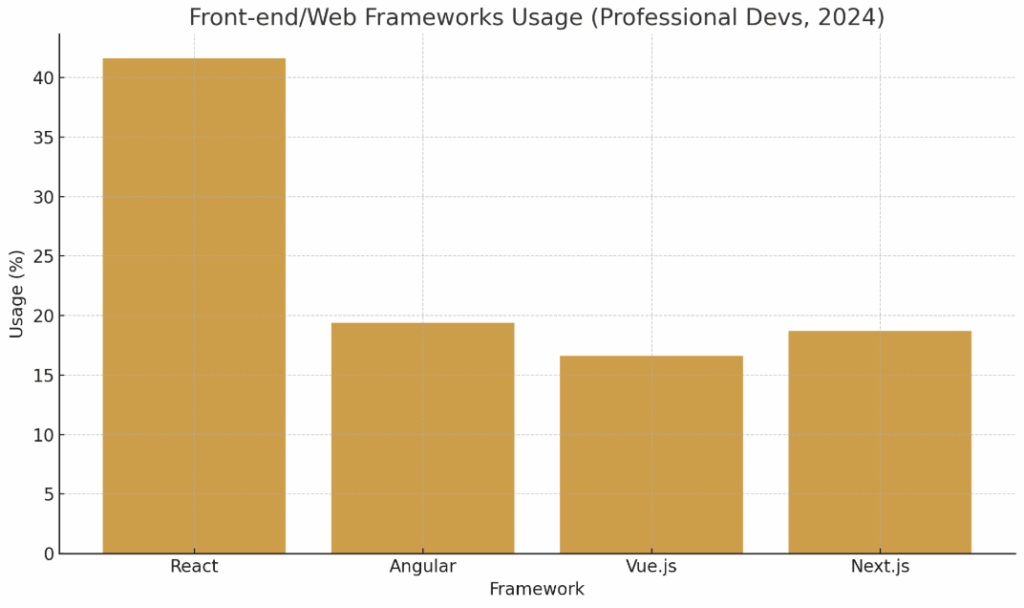
Backend Language Usage (2024–2025)
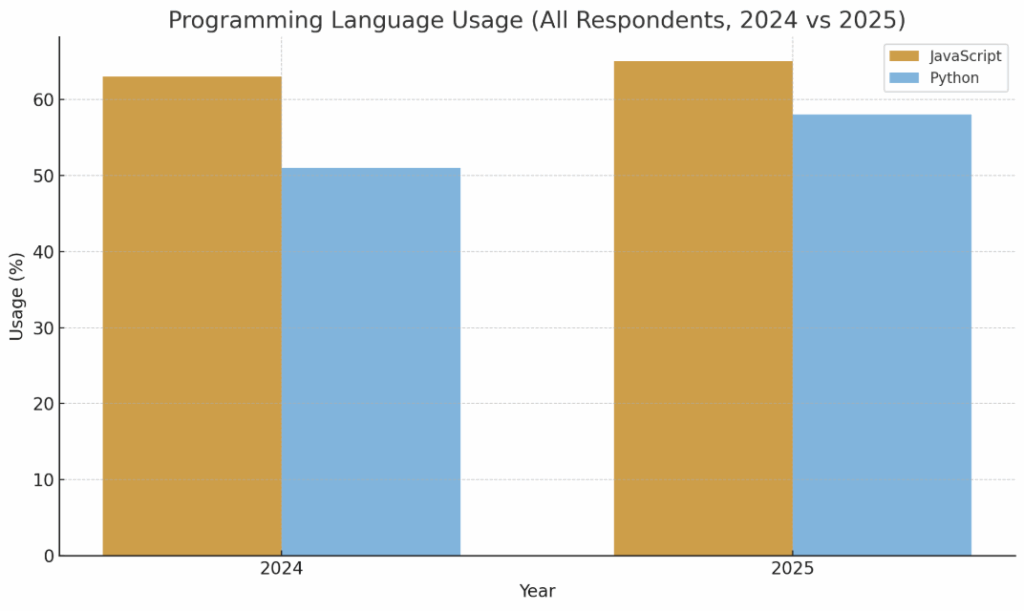
Cloud Market Share (Q2 2024 vs Q2 2025)
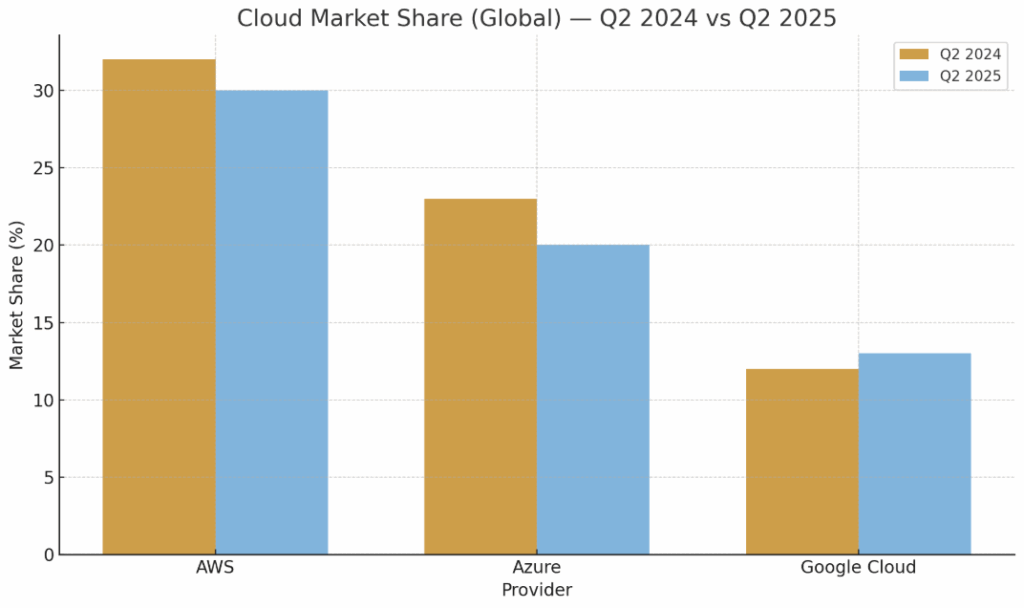
India IT Export Revenue by State
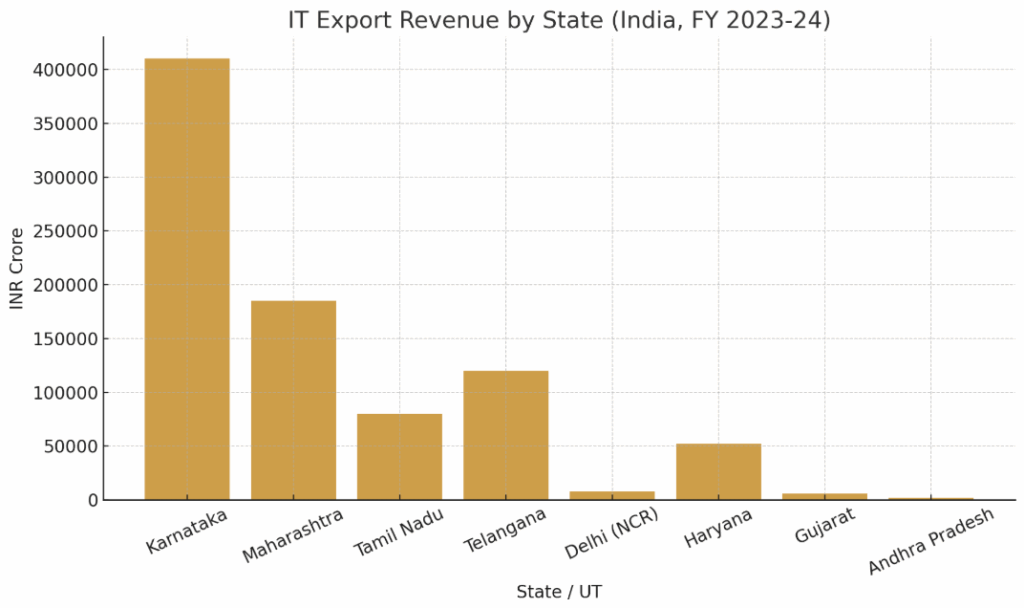
U.S. Digital Economic Impact by State (2025)
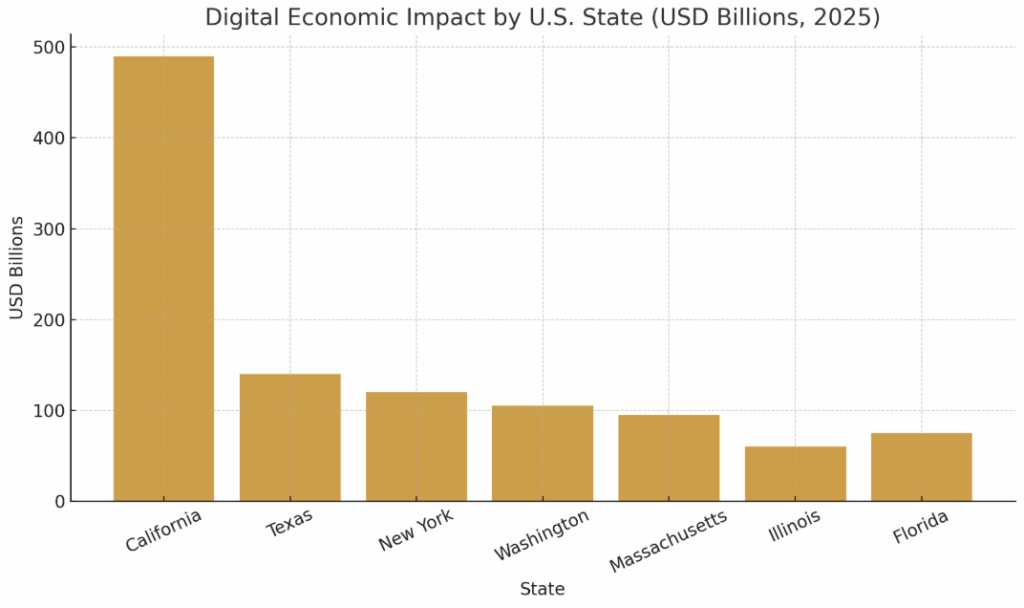
Our Experience-First Approach
Designing from Human Experience Outward
True innovation begins with people — not technology. We design every platform from the outside in, starting with how users think, act, and feel, then engineering backward to make those experiences effortless, secure, and intelligent.
Our approach blends human-centered design, data-driven insights, and adaptive engineering — ensuring innovation happens at every interaction and reliability exists at every layer.
1. Experience & Insight (Start with the User)
We begin by understanding who we’re designing for — mapping journeys, identifying friction points, and turning insights into opportunity. Through design thinking, rapid prototyping, and usability testing, we ensure the experience is validated before a single line of code is written.
- Empathy-led Design Thinking workshops
- Rapid prototyping and A/B validation
- Inclusive, accessibility-first design (WCAG-compliant)
- Continuous user feedback loops
The result: experiences that are natural, intuitive, and meaningful.
2. AI-Driven Development
Once we understand the user journey, we infuse it with intelligence. We integrate AI, analytics, and automation to personalize interactions, improve decisions, and predict user needs in real time.
- Predictive analytics for dynamic UX and recommendations
- Natural Language Processing (NLP) for conversational search
- Machine learning for adaptive interfaces and data insights
- Behavioral analytics to continuously refine experiences
Every web application we build becomes smarter with every user interaction.
3. Engineering for Agility and Scale
Behind every great experience lies architecture engineered for speed, adaptability, and reliability. We build composable, cloud-native, and secure platforms designed for continuous evolution.
- Headless & API-first architectures
- Micro frontends & modular backends for independent scaling
- Progressive Web Apps (PWA) for offline and app-like performance
- Cloud-native infrastructure (AWS, Azure, GCP)
- Continuous delivery pipelines for rapid, safe releases
Our engineering ensures that user experience never slows down, no matter how fast your business grows.
4. Continuous Optimization (Evolve in Real Time)
Web platforms are living systems — they must continuously sense and respond. After launch, we monitor, analyze, and improve performance and usability using data-driven insights and AI-powered observability.
- Real-time performance analytics and Core Web Vitals tracking
- A/B and multivariate testing for optimization
- AI-assisted anomaly detection and self-healing monitoring
- Continuous iteration to improve engagement and conversion
Transformation isn’t a milestone — it’s an ongoing rhythm of sensing and responding.
5. Collaboration Without Boundaries
We operate as a single, distributed global team. Our experts in India and the United States collaborate seamlessly — combining cost-effective engineering depth with proximity to innovation hubs.
- Cross-functional squads of designers, developers, and data scientists
- Agile sprints, transparent communication, and continuous demos
- Co-creation sessions for shared understanding and joint ownership
This model allows us to sense opportunities faster and respond with precision, true to our name.
Recommended Technology Stack (2024–2025)
Layer
Frontend
Stack
React + TypeScript, Next.js, Tailwind Node.js (NestJS/Express), Python (FastAPI/Django)
Why It Matters
Global leader; fast, responsive, maintainable
Layer
Backend
Stack
Node.js (NestJS/Express), Python (FastAPI/Django)
Why It Matters
Best fit for scalability, APIs, and AI
Layer
Database
Stack
PostgreSQL, MongoDB, Redis
Why It Matters
Balance of consistency, performance, and flexibility
Layer
Integration
Stack
REST & GraphQL APIs
Why It Matters
Decoupled, secure, and future-proof
Layer
Infrastructure
Stack
AWS / Azure / GCP
Why It Matters
Global coverage, managed reliability
Layer
AI Tooling
Stack
OpenAI API, LangChain, TensorFlow, PyTorch
Why It Matters
Powering automation, chat, and data intelligence
Layer
Stack
Why It Matters
Frontend
React + TypeScript, Next.js, Tailwind Node.js (NestJS/Express), Python (FastAPI/Django)
Global leader; fast, responsive, maintainable
Backend
Node.js (NestJS/Express), Python (FastAPI/Django)
Best fit for scalability, APIs, and AI
Database
PostgreSQL, MongoDB, Redis
Balance of consistency, performance, and flexibility
Integration
REST & GraphQL APIs
Decoupled, secure, and future-proof
Infrastructure
AWS / Azure / GCP
Global coverage, managed reliability
AI Tooling
OpenAI API, LangChain, TensorFlow, PyTorch
Powering automation, chat, and data intelligence
Best Practices: What Works Consistently
Building with Excellence, Intelligence, and Accountability
Through years of global delivery across enterprise-scale systems, we’ve refined the practices that consistently separate successful, scalable applications from those that plateau. These principles form the backbone of every project we deliver.
1. Performance First — Speed is the New UX
Every millisecond matters. User expectations have evolved: 53% of users abandon a site if it takes more than 3 seconds to load. Performance isn’t a post-launch activity — it’s an engineering discipline embedded at every stage.
Our approach:
- Use Core Web Vitals (LCP, FID, CLS) as design constraints, not metrics.
- Employ Next.js edge rendering, code splitting, and lazy loading.
- Optimize images (WebP/AVIF), fonts, and assets through CDNs and prefetching.
- Implement server-side caching (Redis, CloudFront) and client hints for adaptive delivery.
- Benchmark every build against Lighthouse and WebPageTest targets.
Performance drives engagement, SEO ranking, and brand trust — it’s where experience begins.
2. Accessibility Always — Inclusion by Design
Accessibility isn’t compliance; it’s compassion codified. With over 1 billion people globally living with disabilities, inclusive design is a necessity, not an afterthought.
Our standards:
- Follow WCAG 2.2 AA across all interfaces.
- Ensure keyboard navigation, focus order, and ARIA roles are properly implemented.
- Maintain color contrast ratios (≥4.5:1) and scalable typography.
- Test with NVDA, VoiceOver, and TalkBack to ensure assistive compatibility.
- Adopt semantic HTML5 for clarity and SEO synergy.
Accessibility is everyone’s experience — and our code reflects that.
3. API-First Development — Composability and Future-Proofing
Modern digital ecosystems thrive on interoperability. We design APIs as products — versioned, documented, and governed.
Our principles:
- Start with OpenAPI/Swagger specifications before writing code.
- Enforce schema validation and automated contract tests.
- Design for idempotency, pagination, and graceful error handling.
- Support both REST and GraphQL for consumer flexibility.
- Maintain consistent naming, authentication, and rate-limiting policies.
An API is not a side effect of development — it’s the contract that guarantees stability and scalability.
4. Observability by Default — Visibility Creates Velocity
We build transparency into our systems. Observability isn’t about metrics; it’s about understanding the story your system is telling.
Our observability stack:
- Distributed tracing via OpenTelemetry or Datadog APM.
- Centralized logging (ELK, CloudWatch, Loki) with correlation IDs.
- Real-time dashboards for both engineering and product KPIs.
- Error budgets and SLOs for proactive response.
- AI-driven anomaly detection and predictive alerts.
When you can see everything, you can fix anything — fast.
5. Security Everywhere — Shift-Left and Stay Secure
Security is built in, not bolted on. We adopt Shift-Left Security, embedding it from the first commit.
Our framework:
- Secure coding aligned with OWASP Top 10 and ASVS.
- Automated SAST, DAST, and dependency scans in every CI/CD pipeline.
- Implement Zero Trust principles — identity, access, and network segmentation.
- Protect APIs with JWT/OAuth2 and mutual TLS where required.
- Continuous security monitoring with CSP, HSTS, and intrusion detection.
We treat every deployment as if it’s already under attack — so our clients never have to.
6. Data Privacy and Compliance — Trust by Default
In an era of global regulation, compliance is culture. From GDPR in Europe to CCPA in the U.S. and DPDP in India, we treat privacy as a first-class design goal.
Our practices:
- Data minimization and purpose limitation principles.
- Encryption at rest (AES-256) and in transit (TLS 1.3).
- Regular PII audits and consent tracking mechanisms.
- Region-aware deployment for data sovereignty.
- Periodic penetration testing and compliance certification support.
Trust isn’t earned with policies — it’s built through privacy-conscious design.
7. Collaboration Without Silos — One Team, One Vision
Agile isn’t just a process — it’s a mindset of shared ownership. We ensure clients, developers, and designers work in the same rhythm.
Our collaboration model:
- Integrated Agile delivery pods combining UX, dev, QA, and data.
- Shared backlogs, demo reviews, and sprint retrospectives.
- Transparent reporting via dashboards and burn-downs.
- Cross-regional teams in India and the U.S. ensuring continuous delivery cycles.
Our clients never feel outsourced — they feel extended.
8. Continuous Testing and Automation — Quality at Speed
The faster you release, the faster you learn — but only if quality keeps up.
Our automation strategy:
- Unit tests for logic integrity, integration tests for system stability.
- Visual regression and end-to-end testing using Cypress and Playwright.
- Security and performance testing as part of CI/CD gates.
- Test coverage thresholds defined as part of Definition of Done (DoD).
- AI-assisted test generation to detect edge cases early.
Automation ensures every release is as safe as the first — no surprises, no regressions.
9. Continuous Improvement — The Sense & Respond Way
Digital excellence isn’t static — it’s iterative. We monitor, measure, learn, and evolve continuously.
Our cycle:
- Sense: Capture telemetry, feedback, and performance metrics.
- Analyze: Identify trends, friction, or emerging opportunities.
- Respond: Deploy improvements rapidly and safely.
This is not just our process — it’s our name, our DNA, and our promise.
Lessons Learned: What Not to Do
Insights from Real-World Transformation Projects
After years of building enterprise-grade web applications, we’ve seen consistent patterns that separate success from struggle. Here’s what we’ve learned — and how we help our clients avoid common pitfalls.
Lessons Learned: What Not to Do
Insights from Real-World Transformation Projects
After years of building enterprise-grade web applications, we’ve seen consistent patterns that separate success from struggle. Here’s what we’ve learned — and how we help our clients avoid common pitfalls.
1. Building Before Understanding the Experience
Starting with tools instead of users leads to poor adoption. → Begin with user journeys, not frameworks.
2. Over-Engineering the Architecture Too Early
Microservices without scale = complexity without value. → Start modular, evolve to services when scale demands.
3. Ignoring Performance Budgets
Every 1-second delay can drop conversions by 7%. → Treat Core Web Vitals as design constraints, not metrics.
4. Deferring Security and Compliance
Security added later costs 6× more to fix. → Integrate DevSecOps and Zero-Trust from day one.
5. Neglecting Accessibility
One in four users need accessibility features. → Accessibility is brand inclusion, not optional compliance.
6. Designing Without Observability
You can’t improve what you can’t measure. → Embed logs, traces, and metrics from the start.
7. Treating Content & Data as Afterthoughts
Inflexible CMS and poor analytics limit personalization. → Define content models and event tracking upfront.
8. Ignoring the Human Side of Change
Tech fails if people don’t adopt it. → Train, communicate, and empower teams continuously.
9. Over-Reliance on Third-Party Components
Dependency bloat = long-term maintenance debt. → Own core logic; audit dependencies regularly.
10. Skipping Continuous Testing
Manual QA alone can’t keep up with CI/CD velocity. → Automate tests and enforce quality gates in pipelines.
11. No Clear KPIs or Success Metric
Launching without metrics kills learning. → Tie UX and performance KPIs to business goals.
12. Treating Go-Live as the Finish Line
Without iteration, even great systems stagnate. → Adopt a Sense & Respond mindset — monitor, learn, evolve.
Global Perspective
India
- Contributes over $800 B in IT exports (FY 2023–24).
- Bengaluru (26%), Hyderabad (14%), and Pune/Chennai (10%) lead India’s digital talent base.
- Rapid rise in cloud-native and AI-powered engineering talent.
United States
- California ($492.8 B) leads the world’s digital economy.
- Texas ($141.7 B) and New York ($123.4 B) follow closely.
- Washington, Massachusetts, and Colorado are AI innovation hubs, with AI adoption > 7% of firms.
Together, these regions power our delivery model — combining the engineering depth of India with the innovation energy of the U.S.
